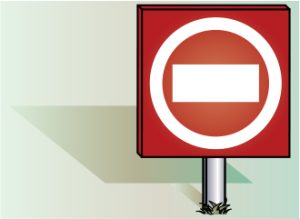Airports come in all shapes and sizes. Some have long, hard-surfaced runways while others have short, grass runways. Some have operating control towers to regulate the flow of traffic in airspace around the airport as well as on the ground, and others do not. Airport pavement markings and signs provide information that is useful to a pilot during takeoff, landing, and taxiing. Uniformity in airport markings and signs from one airport to another enhances safety and improves efficiency. All markings and signs can be found in Chapter 2, Section 3 of the Aeronautical Information Manual. Today, we’ll look at taxiway and runway markings with an excerpt from The Pilot’s Manual: Ground School (PM-2).
Taxiway Markings
Taxiway markings are yellow. The taxiway centerline may be marked with a continuous yellow line, and the edges of the taxiway may be marked by two continuous yellow lines 6 inches apart. Airplanes should taxi with their nosewheel on the yellow centerline.
 Figure 1. Taxiway markings are in yellow. (Click to expand.)
Figure 1. Taxiway markings are in yellow. (Click to expand.)
Taxiway holding lines, across the width of the taxiway, consist of two continuous and two dashed yellow lines, spaced 6 inches between dashes. The two continuous lines are on the side from which an aircraft will approach a runway when taxiing, and if you are instructed to hold short of the runway or if you are not cleared onto the runway, you should stop with no part of the aircraft extending beyond the holding line.
Taxiway and Runway Signs
Next to the holding line at the edge of the taxiway there may be runway holding position signs with white characters on a red background. There may also be a runway boundary sign that faces the runway and is visible to pilots exiting the runway. It will also be adjacent to the holding position marked on the pavement and may even be painted on the rear face of the holding sign. The sign has black markings on a yellow background. After landing, you will be clear of the runway when your aircraft is completely past this sign and the holding lines on the pavement. A no-entry sign (red and white) prohibits the entry of an aircraft.
 Figure 2. Runway holding position sign.
Figure 2. Runway holding position sign.
 Figure 3. Runway boundary sign.
Figure 3. Runway boundary sign.
Runway Markings
Runway markings vary in complexity according to the operations likely to occur on that particular runway. To assist pilots landing and stopping at the conclusion of a successful precision instrument approach, some precision instrument runways have very specific markings, as shown in figure 7.
Ensure that you know whether the full length of the runway is available for landing or not. A displaced threshold showing the start of the landing portion of the runway will be indicated by white arrows pointing to a thick white solid line across the runway, or by yellow chevrons. If arrows are used, that part of the runway may be available for takeoff, but not for landing. If chevrons, rather than arrows are used, then that part of the runway is only suitable for use during an aborted takeoff (as a stopway). If the whole runway is totally unusable, it will have a large cross (×) at each end.
 Figure 5. Displaced threshold markings. (Click to expand.)
Figure 5. Displaced threshold markings. (Click to expand.)
![]() Figure 6. Closed runway (or taxiway).
Figure 6. Closed runway (or taxiway).
 Figure 7. Markings on a precision instrument runway. (Click to expand.)
Figure 7. Markings on a precision instrument runway. (Click to expand.)





